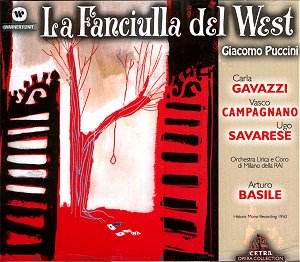Puccini’s La fanciulla del West (The Girl of
the Golden West) was premiered in New York in 1910 with Enrico Caruso
as the outlaw hero Dick Johnson. In the Puccini canon it lies between
Madama Butterfly (premiered in Vienna in1907) and La Rondine
premiered in Monte Carlo in 1917). Although its première was
successful, it has never reached the popularity of Puccini’s golden
trio: Bohème, Tosca and Butterfly. There are no
grand show-stopping arias like ‘Che gelida manina’, rather they grow
seamlessly and are absorbed into the text so that on a first hearing
they can be quite easily missed. In fact Johnson’s main aria, ‘Ch’ella
mi creda ...’ does not arrive until nearly the end of the opera and
then is developed into the glorious climax that ends the opera with
Minnie and Johnson riding off into the sunset – Puccini departing from
his norm, and giving a happy ending. Puccini, himself, believed that
in order to appreciate La fanciulla del West properly, two or
three hearings were necessary. I should hasten to add that the opera
contains plenty of melodies, harmonic and instrumental innovations -
and plenty of lusty action. In fact, for this opera, Puccini moved on
to a more masculine orientated work with the accent on the male voice.
Briefly, the opera is about Dick Johnson, otherwise
known as the outlaw Ramerrez who is resolved to steal miners’ gold stored
for safe-keeping in the saloon run by Minnie. Johnson is being pursued
by Sheriff Jack Rance. Dick falls in love with Minnie and so resists
the temptation to steal the gold. However, Rance is doggedly after him
and in Act II traces him to Minnie’s cabin. When Rance tells Minnie
who Johnson really is and what his intentions are, Minnie throws the
outlaw out but later relents and hides him when he is wounded by Rance’s
men. A drop of Dick’s blood falling from the attic where he is hiding,
gives him away but Minnie, aware that Rance lusts after her, challenges
the sheriff to a game of cards and wins Johnson’s freedom. However in
Act III, set in the Californian forest, the posse has caught up with
Dick and he is about to be lynched when Minnie rides up and appeals
to their better nature. Ultimately, she and Dick are allowed to go free.
This Cetra album was the first complete recording of
the opera, made in November 1950 and the mono sound is very good for
its age. Minnie is sung by the ‘disturbingly beautiful’ (according to
the notes and she does look rather stunning from her photograph) Carla
Gavazzi. She is dreamily romantic in her first Act aria, ‘Laggiu nel
soldad’ – one of the opera’s highlights but she certainly absorbs herself
in the role, showing a rare theatrical verve. You just have to hear
how much of a virago she sounds when she accuses Johnson of treachery
and wins over the malicious Sheriff, a sort of western Scarpia, sung
with dark malevolence and oily slyness by Ugo Savarese. Savarese was
occasionally less than perfectly clear and a little unsteady in his
higher register but always convincing. As Dick Johnson, soft-grained
baritone, Vasco Campagnano is dashing, and heroic and sacrificing in
his famous last act aria, and ardent in his Act I duet with Minnie.
Arturo Basile provides a proficient accompaniment favouring the singers,
including a lusty male voice choir. But he does not forsake Puccini’s
marvellous dramatic and colourful orchestral effects which undeniably
evoke a western setting but also have, at some points, slightly oriental
inflections and Spanish/Mexican rhythms especially to denote Ramerrez,
alias Johnson, which, I suppose, is permissible considering California’s
Hispanic history.
Although the booklet has a helpful synopsis of the
opera, the libretto is only given in Italian. This is a pity for it
precludes a full appreciation of this less familiar and certainly undervalued
work. I hope to review the recommended DG Zubin Mehta recording of the
opera in the not too distant future and I will return to this recording
as a comparator then.
This historic premiere recording of one of Puccini’s
under-valued operas has powerful performances from its three leads:
the ravishingly beautiful Carla Gavazzi as the feisty saloon-gal Minnie,
Vasco Campagnano as Dick Johnson, her outlaw lover and Ugo Savarese
as the Scarpia-like Sheriff Jack Vance. The direction under the baton
of Arturo Basile is compelling and colourful.
Ian Lace


